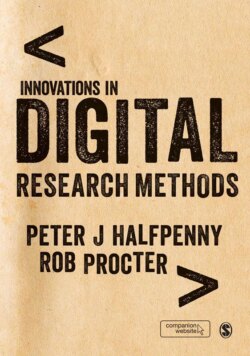Читать книгу Innovations in Digital Research Methods - Группа авторов - Страница 14
На сайте Литреса книга снята с продажи.
1.2.2 e-Social Science
ОглавлениеFrom the start of the e-Science programme, the ambitions of grid computing were less matched to those disciplines subsequently encouraged to join the e-Science bandwagon, including the social sciences, where a mixture of numerous quantitative and qualitative methods is used to pursue relatively small-scale issues. These disciplines have very few generic problems requiring complex middleware to coordinate huge distributed computing and data resources. What requirements they do have were already – before the e-Science programme was initiated – well-served by established commercial and open-source packages to, for example, computer-assist personal interviewing, deliver Web-based surveys, manipulate and statistically analyse quantitative data, sort and code qualitative data, and visualize findings in tables, graphs and network diagrams. Moreover, competition between the commercial package vendors seeking sales to the market research industry as well as to the social research community maintained a flow of updates, including integration of different tasks from around the research cycle into single packages. Similarly, much of the open-source software continued to develop through the efforts of often very active and technically adept support groups.
As the NCeSS research programme unfolded within the changing technical environment, instead of focussing on grid computing, e-Social Science broadened out to include a diverse range of initiatives exploring how computer support and networking, as well as new sources of data including that harvested from the Web, could be used in new ways to capture people’s views and map their behaviours and their networks. These projects included an exploration of new forms of digital data, such as mobile phone logs and GPS to track people’s interactions (see Chapter 9); the creation and exploitation of metadata (that is, data about data, such as its provenance) to facilitate the sharing and reuse of research data (Edwards et al., 2011); linking data about individuals from different sources and the confidentiality and ethical issues that this raises (Duncan et al,. 2011); webometrics, that is, measuring the number, types and patterns of hyperlinks in the Web (Thelwall, 2009); creating maps of geo-referenced data to reveal patterns such as the location of crime hotspots (Hudson-Smith et al., 2009); large-scale social simulations of, for example, the demand for housing in a city and how it changes over time (Birkin et al., 2010); parallelization of statistical routines to make more efficient use of computing time (Das et al., 2010); enabling researchers to collaborate in marking up videos to highlight significant aspects of the social interactions they record (Fraser et al., 2006); mining large bodies of unstructured text for patterns (Ananiadou et al., 2009a; 2009b); and developing software for delivering behavioural interventions over the Internet (Webb et al., 2010). Many of these initiatives will be further described in the chapters that follow.
As these examples reveal, the e-Social Science programme became highly disparate, expanding to include an increasingly wide range of emerging digital technologies, and drawing on many of the new forms of digital data that were becoming increasingly accessible. The various projects demonstrated that a modest input of technical support could ease existing research processes. This proved particularly productive when there was very close engagement between computer scientists and social scientist users in order to track and respond to changing requirements so that research practices and computing tools could co-evolve. However, successful co-production requires that effective local support structures are established and delivered ‘at the elbow’ of the users (Procter et al., 2013a). This leads on to the wider issue of user adoption, and the barriers to and facilitators for this.
